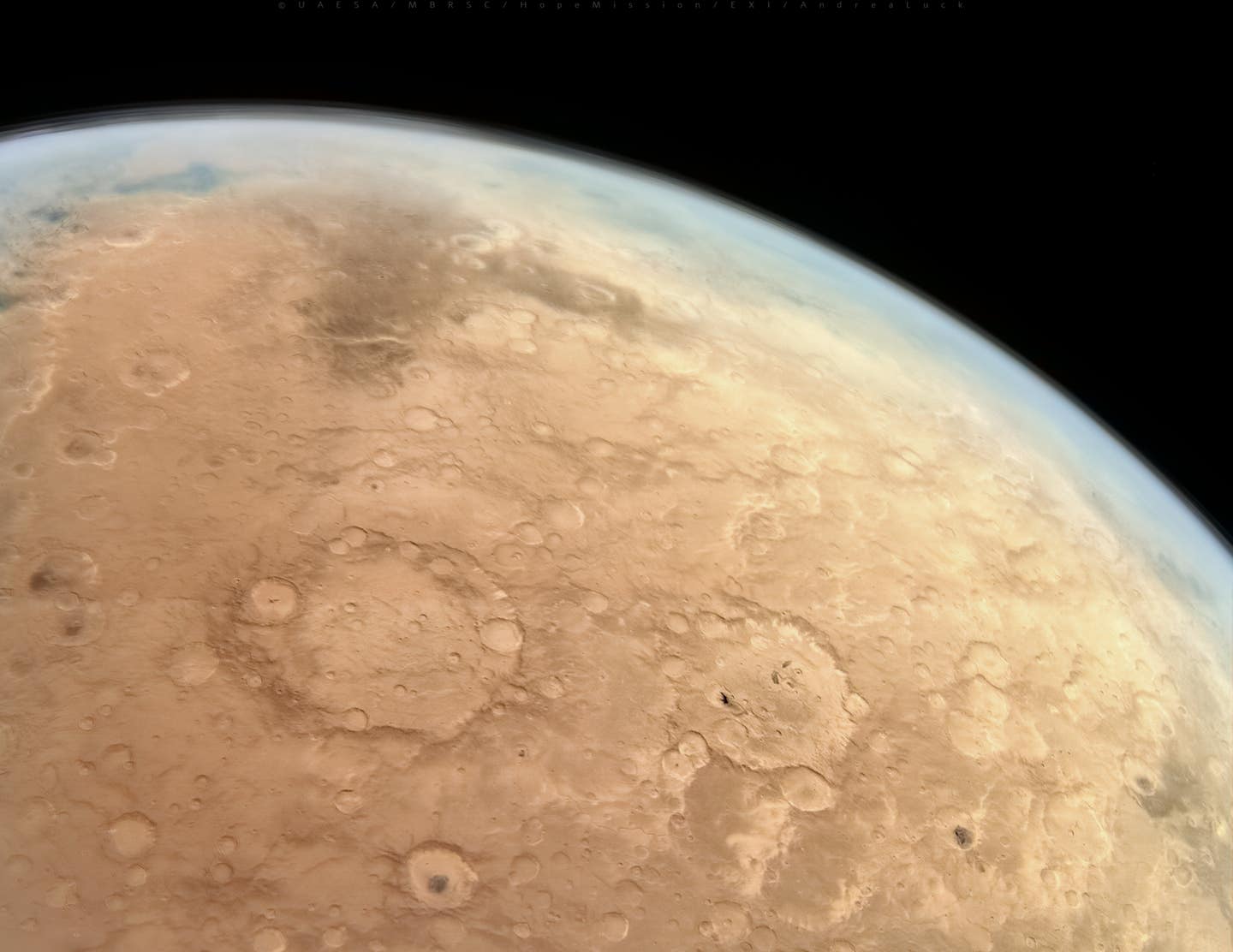Astronomers discover first evidence of hot water on the surface of Mars
Study finds new evidence of water-rich fluids existing on Mars nearly 4.5 billion years ago, shedding new light on the planet’s history.

New research uncovers the oldest evidence of hydrothermal activity on Mars, revealing water-rich conditions 4.45 billion years ago that hint at habitability. (CREDIT: NASA/JPL/Malin Space Science Systems)
Mars' ancient hydrothermal systems may hold the key to understanding its potential for harboring life. These environments, where heat and water interact, are widely regarded as essential for fostering the conditions necessary for life’s development.
For decades, scientists have sought to uncover the origins, distribution, and persistence of these systems on the Red Planet. A recent study published in the journal Science Advances offers groundbreaking evidence of water-rich fluids existing on Mars nearly 4.5 billion years ago, shedding new light on the planet's history.
Mars has captivated researchers with its ancient river channels, lakebeds, and mineral deposits, all suggesting the presence of liquid water in its distant past. Among these findings, phyllosilicates within the Noachian crust—formed more than 3.8 billion years ago—indicate long-term interactions between water and Martian rocks.
Hydrothermal systems may also be tied to Mars' strong crustal magnetization, a clue pointing to an early geodynamo. This magnetic field, generated by the movement of molten iron in the core, would have been critical in shaping the planet's geological and atmospheric evolution. Together, these factors emphasize the importance of studying Mars’ ancient hydrothermal activity to better understand its surface hydrology and deeper geologic history.
The Meteorite Connection
Martian meteorites offer a rare glimpse into Mars’ geological past. Among them, the meteorite Northwest Africa 7034 (NWA7034), nicknamed “Black Beauty,” stands out. It is a polymict regolith breccia—essentially a mixture of fragments from Mars’ surface.
Unlike other Martian meteorites, NWA7034 is rich in water, contains ancient materials dating back 4.4 billion years, and is highly magnetized. These features make it a valuable resource for studying early Martian hydrothermal activity.
Central to this study is a zircon grain from NWA7034. Zircons are durable minerals that can retain evidence of their formation and subsequent history, including impacts and environmental conditions.
Related Stories
This particular grain, dated at 4.45 billion years old, is part of the oldest known population of zircons on Mars, spanning between 4.48 and 4.43 billion years ago. It provides a direct window into the Pre-Noachian period, predating the formation of the regolith breccia it is embedded in.
The zircon grain revealed critical clues through advanced nano-scale geochemical analysis. Researchers detected elemental signatures, including iron, aluminium, yttrium, and sodium, within the grain. These elements suggest the presence of water-rich fluids during the zircon’s formation.
“Hydrothermal systems were essential for the development of life on Earth,” said Dr. Aaron Cavosie of Curtin University’s School of Earth and Planetary Sciences. “Our findings suggest Mars also had water, a key ingredient for habitable environments, during the earliest history of crust formation.”
These geochemical fingerprints provide the oldest known evidence of hot water on Mars. The discovery hints that hydrothermal systems were active as far back as the Pre-Noachian period, over 4.1 billion years ago. These environments, driven by magmatic activity, likely created conditions conducive to habitability.
Adding to its significance, this zircon is the first and only documented "shocked zircon" from Mars. A 2022 study on the same grain revealed deformation twins—features formed under extreme pressure during meteorite impacts.
These conditions, exceeding 20 gigapascals, provide a record of the violent processes that shaped Mars’ crust. However, the shock event recorded in the zircon occurred before the meteorite’s incorporation into NWA7034, further emphasizing the zircon’s ancient origin.
Despite the upheaval caused by massive impacts, the presence of water during this turbulent era is a critical finding. “This new study takes us a step further in understanding early Mars,” Dr. Cavosie said. “It identifies tell-tale signs of water-rich fluids from when the grain formed, providing geochemical markers of water in the oldest known Martian crust.”
Hydrothermal systems on Earth are known to harbor microbial life, even in extreme conditions. Similar environments on Mars could have provided the energy and nutrients necessary to support life. The presence of water-rich fluids during the formation of Mars’ earliest crust suggests the planet may have been habitable, at least intermittently, during its early history.
While Mars’ surface today is inhospitable, these findings reinforce the notion that the planet once had conditions favorable for life. The study also highlights the importance of meteorite analysis in understanding planetary history. Zircons, with their ability to retain detailed geochemical and chronological records, continue to be a vital tool in reconstructing ancient environments.
Expanding Our Understanding
This research offers a new perspective on Mars’ geological and hydrological history. By analyzing a single zircon grain, scientists have unveiled evidence of water activity nearly 4.5 billion years ago.
This discovery contributes to our broader understanding of Mars’ potential for life and the processes that shaped its crust.
As technology advances, further studies of Martian meteorites and future missions to the planet may unlock even more secrets of its past.
Note: Materials provided above by The Brighter Side of News. Content may be edited for style and length.
Like these kind of feel good stories? Get The Brighter Side of News' newsletter.
Joseph Shavit
Head Science News Writer | Communicating Innovation & Discovery
Based in Los Angeles, Joseph Shavit is an accomplished science journalist, head science news writer and co-founder at The Brighter Side of News, where he translates cutting-edge discoveries into compelling stories for a broad audience. With a strong background spanning science, business, product management, media leadership, and entrepreneurship, Joseph brings a unique perspective to science communication. His expertise allows him to uncover the intersection of technological advancements and market potential, shedding light on how groundbreaking research evolves into transformative products and industries.



